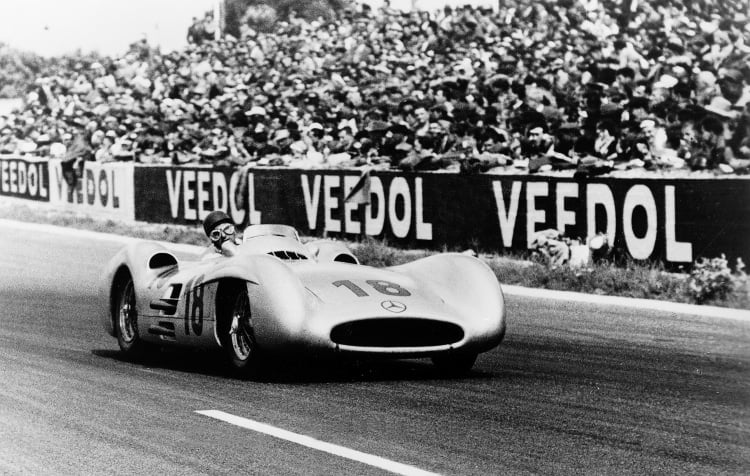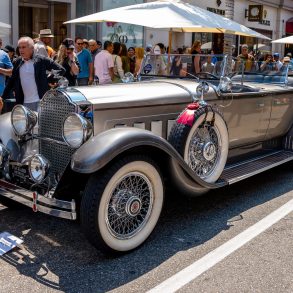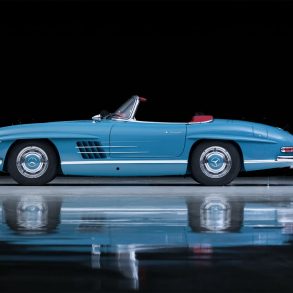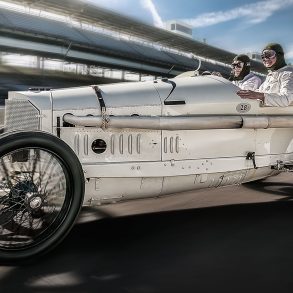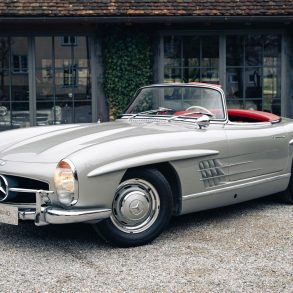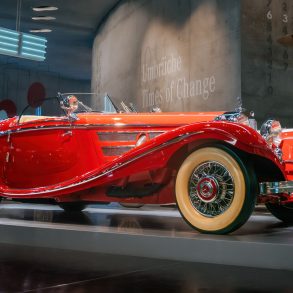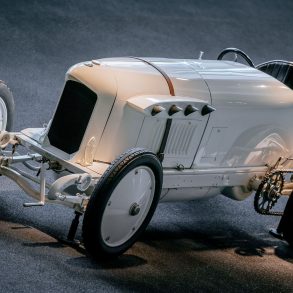Mercedes have an unparalleled motorsport history. Throughout the years, the German manufacturer has been continuously innovating, testing, and retesting. From the invention of the first modern car, the use of four-wheel motors, to the dominance of the Silver Arrows in the 1930s, Mercedes have a long and rich history in motorsports.
This article looks back on the people and races that contributed to Mercedes Benz Motorsport history.
An unforgettable victory by Mercedes Benz to remember is the 1931 win at the Mille Miglia. Rudolf Caracciola and co-driver Wilhelm Sebastian drove the Mercedes-Benz SSKL to victory, beating the local favorites to become the first non-Italians to win.
Another memorable moment includes the 1971 class win and overall second place of Hans Heyer and Clemens Schickentanz at the 24 Hours of Spa-Francorchamps behind the wheel of the first Mercedes-Benz 300 SEL 6.8 AMG.
Two notable characters in Mercedes-Benz history: Juan Manuel Fangio and Rudolf Uhlenhaut. The incredible Argentinian racing driver Fangio was a contemporary of the brilliant development engineer Uhlenhaut. They encountered each other during the 1950s at Mercedes-Benz. Fangio was born 110 years ago, while Uhlenhaut was born 115 years ago.
Juan Manuel Fangio- The Driver
The Formula One World Championship, founded in 1950, was dominated in its first decade by Juan Manuel Fangio.

The Argentine racing driver became a five-time World Champion with four different manufacturers. In 1954 and 1955, he claimed the World Championship with the Mercedes-Benz W 196 R.
On July 4, 1954, in his first foray in the race car, Fangio was able to claim victory at the French Grand Prix in Reims ahead of Karl Kling, his teammate.

German President Theodor Heuss compliments winner Juan Manuel Fangio at the European Grand Prix at the Nürburgring, 1 August 1954
In 1954, he also managed to win the Swiss Grand Prix in Bern, European Grand Prix at the Nürburgring, and the Italian Grand Prix in Monza. The season ended with a World Championship win for Fangio.
The 1955 season started with victory for the Argentinian as he claimed a triumphant win at the Argentine Grand Prix. Despite the excruciating heat, Fangio was the only driver to maintain racing without opting for a change of drivers. He also claimed the win at the Italian and Dutch Grands Prix, giving him his second World Championship win with Mercedes-Benz.

Following Mercedes-Benz’s withdrawal from motorsport, Fangio claimed victory in 1956 under Ferrari and in 1957 under Maserati.
Fangio retired in 1958 with 24 victories in 51 Grand Prix, a success rate of nearly 50%.

In 2019, to find out the greatest Formula One driver of all time, the magazine auto motor und sport used a comprehensive formula to compare all Formula One drivers with one another. After all the data were collected and computed, it revealed that Fangio ranked #1 ahead of Michael Schumacher and Lewis Hamilton.
The race director of Mercedes-Benz in the 1930s and 1950s, Alfred Neubauer, described Fangio stating:
“He understood how to achieve the maximum in all conditions and to use his machine economically. That is to say, he wasn’t a wild daredevil, but had the ability, tactics, and capacity to see the machine as a whole and to adapt this whole to the requirements of that very moment.”

Journalist and Fangio’s biographer Günther Molter described the racer saying:
“Fangio was always shy, reserved, almost distrustful. And, on the other hand, even as a big star, he was always modest, unassuming and human.”
Juan Manuel Fangio died on July 17, 1995 in Beunos Aires.

Rudolf Uhlenhaut -The Developer
Rudolf Uhlenhaut was not just a gifted engineer; he was also an exceptional driver. At Mercedes-Benz, Uhlenhaut was able to make full use of both his talents. He was born in London in 1906 to an English mother and a German father. His father managed the local branch of Deutsche Bank. In 1914, the family moved to Brussels, and in 1919 they moved to Berlin, and eventually, to Bremen. In Munich, Uhlenhaut studied Mechanical Engineering.


In 1931, Uhlenhaut joined the testing department of what was then Daimler-Benz AG as an engineer. Initially, he dealt with the suspension set-up and chassis of the Mercedes-Benz 170 V (W 136) which was first introduced in 1936.
In 1936 Rudolf was appointed technical director of the racing department and he would continue to have the role, shaping race cars well into the 1950s. This signified that commencing 1937, all record cars and Silver Arrows that brought success to the brand all bore his signature.
After the Second World War, Uhlenhaut resumed his work on the 300 SL racing sports car (W 194), the 300 SLR (W 196 S) racing sports car, and the new W 196 R Formula One racing car. It was a great advantage that Uhlenhaut himself was a great driver even at top speeds.
Alfred Neubauer, the race director described him as:
“the only designer who ever understood how to personally drive a heavy car at race speed around a track. He does not need to rely on the assessments of the drivers”.

Uhlenhaut also used his skills to develop several Mercedes-Benz series vehicles – his other responsibility as the leading engineer. He considered the task much more challenging than developing race cars. Uhlenhaut once stated:
“It is much harder to design a good passenger car than a racing car. A racing car has to win races. A passenger car must be robust, must be comfortable, must look good, must have good suspension, must be affordable … and much more.”
In his role as the passenger car development director, he greatly impacted many series vehicles by Mercedes-Benz with his influence spanning almost 40 years.

At the conclusion of his career, he even created the Mercedes-Benz S-Class of model series 116, which made its debut in 1972, the same year of his retirement. His technical expertise matched perfectly with his clear and modest demeanor.
Uhlenhaut contributed greatly to the company on an international stage with expert knowledge, charm, and charisma. He passed in Stuttgart on May 8, 1989.
Rudolf Caracciola – Victory after a 16-hour Non-stop Race
In 1931, Rudolf Caracciola and his co-driver Wilhelm Sebastian registered for the Mille Miglia along with 150 other teams.

During these economically challenging times, they participated in the race as a private team rather than a factory team. They entered the race with the legendary Mercedes-Benz SSKL (Super-Sport-Kurz-Leicht or super-sport-short-light, W 06 RS). It was the fourth and final model of the S series, with only four having racing-exclusive specs.
The roads to Rome were narrow, and it was only the road from the starting point and towards the finish, through the town of Brescia, was Caracciola and the other racers able to drive at full throttle for many miles. The team had a record finish time of 16 hours, 10 minutes, and 10 seconds with an average speed of 101.6kph.

Since 1955, Stirling Moss and Denis Jenkinson have held and kept the record for the Mille Miglia. They finished the road race in just 10 hours, 7 minutes, and 48 seconds, beating their teammate Juan Manuel Fangio in their Mercedes-Benz 300 SLR (W 196 S). They achieved a record average speed of 157.65kph, which has not been challenged since.
Mercedes-AMG victory in Spa-Francorchamps
For AMG, the 1971 24 Hours of Spa-Francorchamps was the first international success in motorsport after they claimed the class victory and second overall finish with the Mercedes-Benz 300 SEL 6.8 AMG with Hans Heyer and Clemens Schickentanz behind the wheel.

With roughly 80 participants, the 1,635kg heavy saloon was an obvious underdog. Though the Spa-Francorchamps’ old, 14,863km course gave the luxury saloon a bit of an advantage.
Heyer and Schickentanz were able to get ahead of their competitors on the long straights, although they were at a disadvantage when braking and around the corners.

They made up for it at the fastest racetrack in Europe near Monza, where the ‘red pig’ as the Mercedes-Benz was called by fans, was always part of the leading group.
After 24 hours, only 18 teams crossed the line, with the ‘red pig’ claiming second place. Only Dieter Glemser and Alex Soler-Roig in the Ford Capri RS 2600 were ahead of them. Glemser became the Mercedes-Benz factory driver from 1963-1965, and until today, he works as a Brand Ambassador for the company.
In the 1970s, Mercedes-Benz was a long way from factory involvement in racing, however, AMG desired to make a name for their young company, by privately using a competition touring car.

Authentic reconstruction of the Mercedes-Benz 300 SEL 6.8 AMG racing saloon (W 109), dating from 2006.
AMG head Hans Werner Aufrecht picked the Mercedes-Benz 300 SEL 6.3 (W 109) which was introduced in 1968 as their base vehicle. The displacement of the eight-cylinder engine was increased from 6.3 to 6.8 liters, the drivetrain produced 315 kW (428hp) in the race and offered a powerful 620Nm torque. The four-door saloon had a top speed of 265kph.
They received the base vehicle from a car that was damaged in an accident and arranged a new bodyshell. Two years of detail work produced a touring car that was lighter than the series model by a full 195kg.

After the race, even the German evening news, ARD Tagesschau, reported on the victory. The ‘auto, motor und sport‘ magazine dubbed the vehicle as a “stroke of Swabian genius”.
The AMG name became an overnight sensation. Unfortunately, the original vehicle that was used was converted to be used for aircraft tires test drives and no longer exists.

From July 20 to September 19, 2021, the Mercedes-Benz 300 SEL 6.8 AMG will be exhibited in the atrium of the Mercedes-Benz Museum, allowing visitors to experience it free of charge.
[Source: Daimler]


